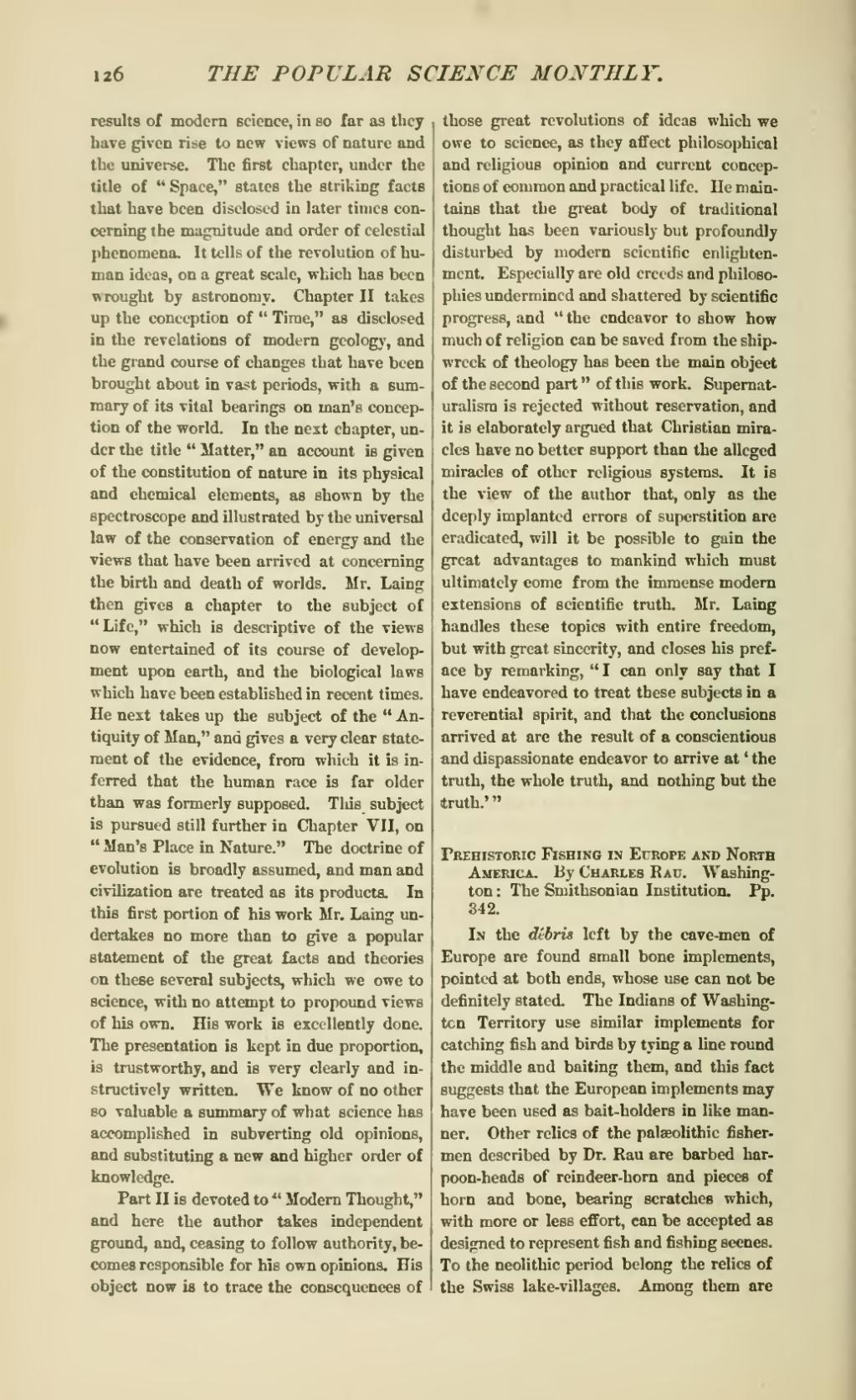results of modern science, in so far as they have given rise to new views of nature and the universe. The first chapter, under the title of "Space," states the striking facts that have been disclosed in later times concerning the magnitude and order of celestial phenomena. It tells of the revolution of human ideas, on a great scale, which has been wrought by astronomy. Chapter II takes up the conception of "Time," as disclosed in the revelations of modern geology, and the grand course of changes that have been brought about in vast periods, with a summary of its vital bearings on man's conception of the world. In the next chapter, under the title "Matter," an account is given of the constitution of nature in its physical and chemical elements, as shown by the spectroscope and illustrated by the universal law of the conservation of energy and the views that have been arrived at concerning the birth and death of worlds, Mr. Laing then gives a chapter to the subject of "Life," which is descriptive of the views now entertained of its course of development upon earth, and the biological laws which have been established in recent times. He next takes up the subject of the "Antiquity of Man," and gives a very clear statement of the evidence, from which it is inferred that the human race is far older than was formerly supposed. Tins subject is pursued still further in Chapter VII, on "Man's Place in Nature." The doctrine of evolution is broadly assumed, and man and civilization are treated as its products. In this first portion of his work Mr. Laing undertakes no more than to give a popular statement of the great facts and theories on these several subjects, which we owe to science, with no attempt to propound views of his own. His work is excellently done. The presentation is kept in due proportion, is trustworthy, and is very clearly and instructively written. We know of no other so valuable a summary of what science has accomplished in subverting old opinions, and substituting a new and higher order of knowledge.
Part II is devoted to "Modern Thought," and here the author takes independent ground, and, ceasing to follow authority, becomes responsible for his own opinions. His object now is to trace the consequences of those great revolutions of ideas which we owe to science, as they affect philosophical and religious opinion and current conceptions of common and practical life. He maintains that the great body of traditional thought has been variously but profoundly disturbed by modern scientific enlightenment. Especially are old creeds and philosophies undermined and shattered by scientific progress, and "the endeavor to show how much of religion can be saved from the shipwreck of theology has been the main object of the second part" of this work. Supernaturalism is rejected without reservation, and it is elaborately argued that Christian miracles have no better support than the alleged miracles of other religious systems. It is the view of the author that, only as the deeply implanted errors of superstition are eradicated, will it be possible to gain the great advantages to mankind which must ultimately come from the immense modern extensions of scientific truth. Mr. Laing handles these topics with entire freedom, but with great sincerity, and closes his preface by remarking, "I can only say that I have endeavored to treat these subjects in a reverential spirit, and that the conclusions arrived at are the result of a conscientious and dispassionate endeavor to arrive at 'the truth, the whole truth, and nothing but the truth.'"
Prehistoric Fishing in Europe and North America. By Charles Rau, Washington: The Smithsonian Institution. Pp. 342.
In the débris left by the cave-men of Europe are found small bone implements, pointed at both ends, whose use can not be definitely stated. The Indians of Washington Territory use similar implements for catching fish and birds by tying a line round the middle and baiting them, and this fact suggests that the European implements may have been used as bait-holders in like manner. Other relics of the palæolithic fishermen described by Dr. Rau are barbed harpoon-heads of reindeer-horn and pieces of horn and bone, bearing scratches which, with more or less effort, can be accepted as designed to represent fish and fishing scenes. To the neolithic period belong the relics of the Swiss lake-villages. Among them are
